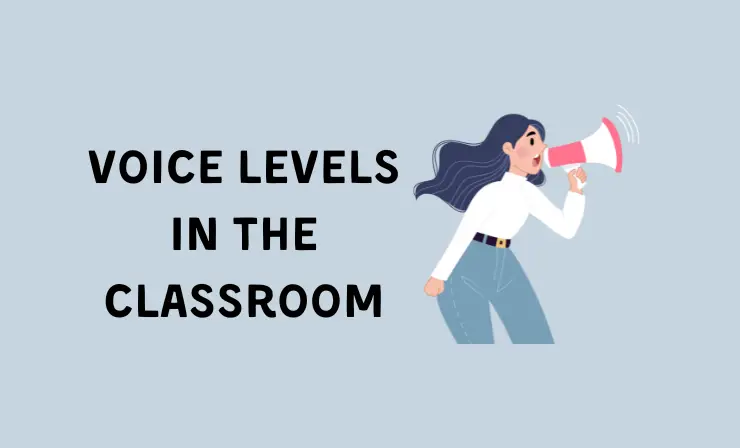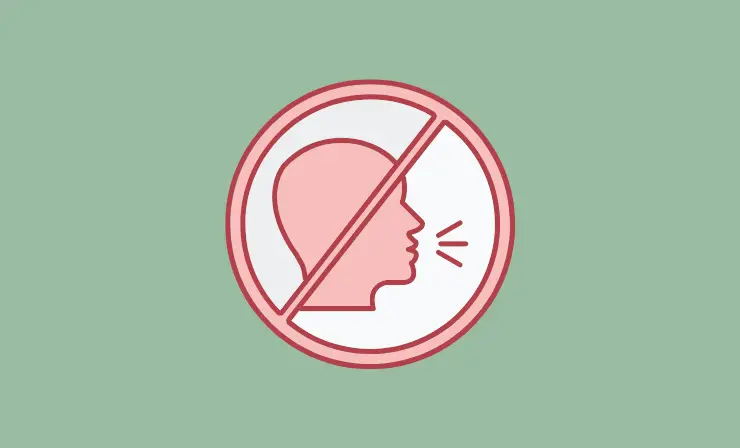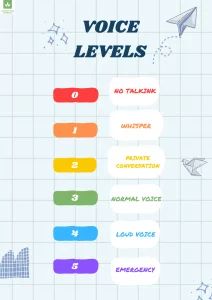Having voice levels in the classroom is an essential part of maintaining a productive learning environment. It ensures that students are able to stay focused and on task, while also allowing for collaboration and interaction with peers. But voice levels can be hard to get right—too loud or too quiet can lead to miscommunication, confusion, and disruption.

Establishing explicit expectations can be a powerful weapon for classroom management. When instruction begins, providing students with clear direction provides the foundation of success. Far from being mundane or obvious tasks, setting these guidelines allows for smoother execution and comprehension, which ultimately leads to better outcomes across all areas—academically as well socially.
In this article, we’ll explore why voice levels are so essential, what they look like in practice, and tips for getting them just right. Especially, you’ll know about:
- 6 Voice Levels in the Classroom →
- Why is It Important to Set Voice Levels? →
- How Can We Establish Voice Levels? →
- 8 Tips for Teachers About Voice Levels →
- Bonus (Poster) →
6 Types of Voice Levels in The Classroom
Having voice levels in the classroom is essential for creating an optimal learning environment. It allows students to express themselves without disrupting the learning process, and encourages mutual respect among everyone in the class.
Voice Level 0
Voice Level 0 is when there is no talking in the classroom. This means that everyone is quiet and not talking to each other. This usually happens during silent reading or when students are working by themselves. In a science lab, voice level 0 might happen when the teacher gives instructions at the beginning or when someone else is presenting information. This voice level should be respected so that everyone can focus and learn.

Voice Level 1
This voice level is defined as a low conversation voice. This voice should be used when students are working together in groups, when they are discussing the material and bouncing ideas off one another. 1 voice level should also be used during discussions with the whole class. If a student has a question or comment, they should voice it respectfully.

Voice Level 2
At this level, people are talking in small groups or pairs. Everyone should have a chance to talk, and everyone else should listen. Use a quiet voice so you don’t disturb the other conversations.

Voice Level 3
This level is for when someone is talking to the entire class. They should use a voice that projects across the room and can be heard easily by everyone in the class. It shouldn’t be too loud, but it should also be confident. This voice level helps define the other three voice levels.

Voice Level 4
It is used when outside the classroom. It needs to be loud enough that everyone can hear you. It should be loud enough to catch the attention of everyone in the surrounding area. This voice is also used when giving directions or safety instructions, so it needs to be clear and authoritative.

Voice Level 5
It is reserved for emergencies only. The only time students should use Voice Level 5 is if there’s an emergency situation. It should sound urgent and commanding, and should be loud enough to alert everyone in the building. This voice level is only used when absolutely necessary.
Why is It Important to Set Voice Levels?
It’s important to set voice levels in the classroom to create an environment of respect and focus. By establishing voice levels, students learn how to communicate appropriate volume for each situation. This helps students stay on task during class activities and learn how to collaborate with one another at the proper sound level.

Additionally, setting voice levels keeps learning environments free of distraction from high volumes and encourages respect among classmates by teaching appropriate conversation etiquette. In addition, it also sets expectations for teachers when talking with their students by modeling acceptable behavior for them to follow. Overall, setting voice levels is critical for creating a successful and respectful learning environment.
How Can We Establish Voice Levels?
During the first week of school, it’s indispensable to establish classroom expectations – and that includes setting proper voice volume. Kids may not understand what a whisper sounds like compared to utter silence; so use this opportunity as an educational moment!

Have students practice sounding out different volumes—from loud clear audio, down to soft whispers, all the way until they can hear complete tranquil stillness. This will give your class a great start on understanding their vocal etiquette in every situation throughout their academic year.
Working in class is a bit like orchestrating an ensemble. I enlist the help of students to show their peers what each voice level looks and sounds like, such as quiet work time or when they can speak at normal volume.
8 Tips About Voice Levels for Teachers
- Establish voice level expectations at the beginning of each class period by modeling appropriate voice levels and teaching students to self-regulate their voice volume.
- Encourage student participation with verbal cues, such as thumbs up and nod affirmations for quiet voices when necessary.
- Provide positive reinforcement to reinforce desired behavior and voice levels during class discussions, such as praise or rewards like “cool points” for using appropriate voice levels in the classroom.
- Remain calm and consistent in your response to inappropriate voice levels; take a deep breath before responding so that you don’t react out of anger or frustration but rather from a place of understanding
- Utilize non-verbal communication techniques like facial expressions and body language to communicate desired voice levels without having to interrupt instruction
- Use humor when addressing inappropriate voice level issues so that it doesn’t become an adversarial situation between teacher/student
- Display visual reminders (elevation chart) around the room providing timely reminders about expected voices throughout the day8
- Encourage students who are struggling with maintaining appropriate vocal behaviors through one-on-one conversations or small group interventions.
Sometimes your own voice can be too weak. In that case, we recommend that you use a vocal amplifier. In the video below, we review the 9 best teacher amplifiers.
Bonus: Voice Level Poster for Classroom
The voice level system should be revisited periodically, and role-played or practiced in the classroom to ensure that students are familiar with the voice levels and understand when each voice level is appropriate. Doing voice level practice regularly can help to keep voice expectations top of mind for students. Ultimately, it will help to create a respectful and productive classroom atmosphere.
Our readers now have an exclusive opportunity to access our educational poster! We’ve crafted this resource with the intention of helping you and your students gain a better understanding of this topic. Check it out!

Download a PNG file in high resolution
Useful Recourses
- 15 Awesome Classroom Management Books
- 20 Classroom Management Strategies and Techniques
- 10 Tips for Dealing with a Difficult Child
Conclusion
Maintaining voice levels in the classroom is an important part of ensuring a productive learning environment. With these tips and techniques, you can help your students learn how to self-regulate their voice volume and create a culture of mutual respect.
By setting expectations at the beginning of each class period, providing positive reinforcement for appropriate voice levels, utilizing non-verbal communication techniques, using humor when necessary, displaying visual reminders around the room, and offering individualized interventions as needed – you’ll be well on your way to creating an optimal learning space where everyone feels comfortable expressing themselves without disturbing others.
- Overview of 22 Low-Code Agencies for MVP, Web, or Mobile App Development - October 23, 2024
- Tips to Inspire Your Young Child to Pursue a Career in Nursing - July 24, 2024
- How Parents Can Advocate for Their Children’s Journey into Forensic Nursing - July 24, 2024



